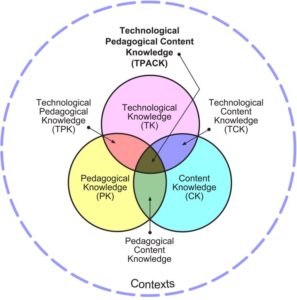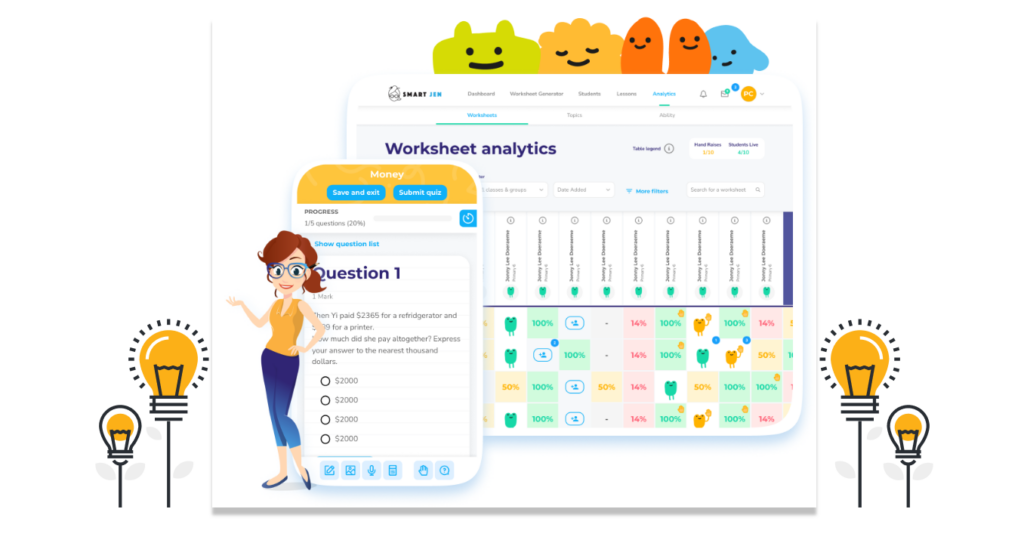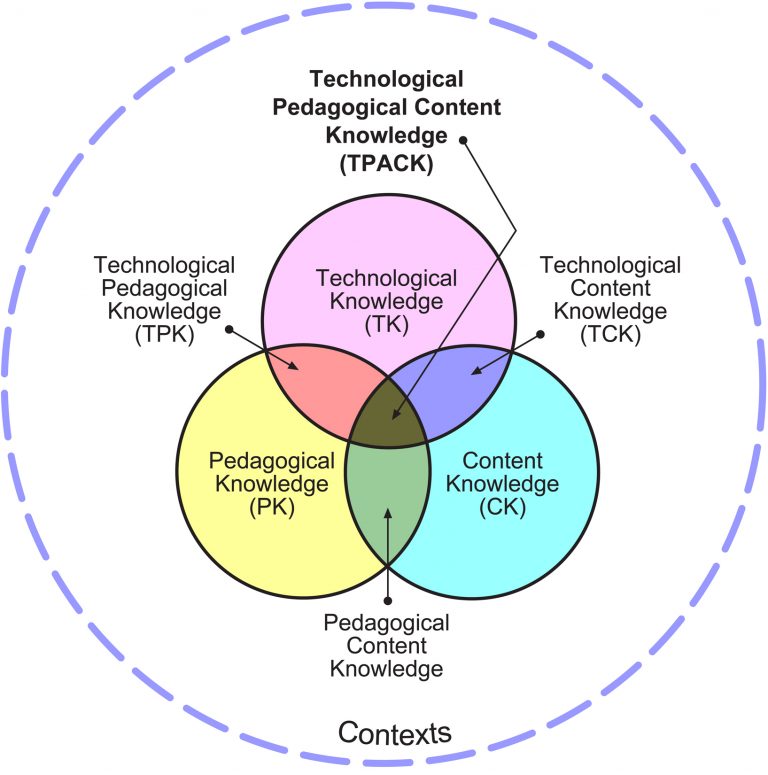How can technology be effectively integrated into teaching and learning? This is a question that many educators are grappling with as technology becomes an increasingly essential part of modern-day education. The answer lies in the TPACK model, a framework that guides educators on how to use technology to improve teaching and learning.
Here you will learn all about the TPACK model, which will help you understand how to use technology to improve teaching and learning.
Introduction to TPACK Model
TPACK represents the intersection of three domains: technological knowledge, pedagogical knowledge, and content knowledge.
Developed by Mishra and Koehler in the late 1990s, the TPACK model emphasises the importance of a deep understanding of what is being taught, the best teaching strategies, the available tools, and the technical skills to use them effectively.
By following this framework, educators can improve their teaching practices and enhance learner-learning outcomes through technology.
If you are curious about how the TPACK model can be applied in the classroom, the following sections of this article will detail and provide a solid understanding of the TPACK model and how it can be utilised to improve technology integration in education.
Why is the TPACK Model important?
The TPACK model offers a complete framework for effectively integrating technology into teaching and learning. But why is the TPACK model so important?
First and foremost, the TPACK model recognises the interdependence of technology, pedagogy, and content. It emphasises the significance of how to use technology to enhance learner learning.
the TPACK model also encourages educators to be lifelong learners, constantly pursuing new knowledge and skills. This motivates the educator to stay up-to-date with the latest tools and techniques.
Finally, by using technology to enhance their teaching practice, educators are encouraged to develop more engaging and effective learning experiences that help learners better comprehend and retain the material.
What is the TPACK Model?
To understand the importance of the TPACK model, it’s helpful to have a clear understanding of what it is.
The TPACK framework comprises three key domains: technological knowledge, pedagogical knowledge, and content knowledge.
At its core, the TPACK model is a framework for integrating technology, content, and pedagogy in the classroom. It identifies that each of these elements is important on its own, but combined can create effective learning experiences for learners.
TPACK Model Components

To aid with the use of technology in education, the components of the TPACK model work in tandem to guide effective technology integration into teaching and learning. Let’s explore each of the TPACK components in more detail.
Pedagogical Knowledge (PK)
Pedagogical knowledge refers to understanding how learners learn, what teaching strategies are most effective, and how to create a positive learning environment.
This knowledge includes understanding instructional strategies, assessment methods, and classroom management techniques. Educators with solid pedagogical knowledge can create engaging and meaningful learning experiences for their learners.
Technological Knowledge (TK)
Technological knowledge refers to understanding the tools and technologies used to support teaching and learning.
This includes a basic understanding of using computers, software, and other digital tools to create and deliver educational content. Educators with solid technological knowledge can use technology to enhance instruction and facilitate learner learning.
Content Knowledge (CK)
Content knowledge refers to the depth of an educator’s understanding of a particular subject area.
This includes knowledge of the discipline’s key concepts, principles, and theories. Educators with solid content knowledge can help learners make connections between different ideas and understand the relevance of the material they are learning.
Pedagogical Content Knowledge (PCK)
Pedagogical content knowledge integrates pedagogical and content knowledge.
This includes understanding how to teach a particular subject area engagingly and effectively for learners. Educators with strong PCK can design lesson plans and activities that help learners develop a deep understanding of the content.
Technological Content Knowledge (TCK)
Technological content knowledge refers to integrating technology and content knowledge.
This includes understanding how technology can teach a particular subject area. Educators with strong TCK can use technology to enhance instruction, facilitate learner learning, and create engaging and interactive lessons.
Technological Pedagogical Knowledge (TPK)
Technological pedagogical knowledge refers to integrating pedagogical and technological knowledge.
This includes understanding how technology can be used to support teaching and learning. Educators with strong TPK can use technology to create and deliver effective instruction and facilitate learner learning.
Technological Pedagogical Content Knowledge (TPACK)
Technological pedagogical content knowledge refers to the intersection of all three areas of knowledge – content, pedagogy, and technology.
This includes understanding how to integrate technology into teaching practices to support learner learning effectively.
Educators with strong TPACK can use technology to improve instruction, facilitate learner learning, and create engaging and interactive learning that helps learners develop a deep understanding of the content.
Read more: SAMR Model: A Complete Guide for k-12 Classroom Technology Integration
TPACK Model Framework
The TPACK model framework is helpful for educators looking to integrate technology into the classroom effectively. The TPACK model recognises that technology is most effective when integrated with content and pedagogy knowledge.
Explanation of TPACK Model Framework
TPACK is an acronym for Technological Pedagogical Content Knowledge. It is founded on the premise that effective technology integration necessitates combining three forms of knowledge.
It is made up of three parts: technological knowledge (TK), pedagogical knowledge (PK), and content knowledge (CK). The TPACK Model Framework’s primary purpose is to achieve technological pedagogical content understanding (TPACK).
The TPACK model framework has established itself as an excellent educational framework, giving a helpful lens through which to evaluate and analyse the use of technology in teaching and learning.
TPACK Model Framework in Practice
In practice, the TPACK model framework can guide the development of educators. It can inform course design and curriculum development and help educators identify which technologies best support their pedagogical and content knowledge goals.
Educators can design learning experiences that engage learners and maximise learning results. They can leverage technology to support and enhance their pedagogical approaches, creating a better dynamic and personalised learning environment for learners.
It can also provide a roadmap for ongoing improvement and professional development, ensuring that educators stay up-to-date with the latest technological advancements and pedagogical best practices.
Applications of TPACK Model Framework
The TPACK model framework has numerous applications in the education sector. It supports educators in designing effective teaching and learning experiences that maximise learner-learning outcomes.
HeyHi Assessment is an example of a tool that aligns with the TPACK Model Framework. Its assessment tools can help educators evaluate learner performance, understanding, and details of each learner’s strengths and weaknesses.
This allows educators to use technology, create targeted learning experiences, and personalised teaching approaches that meet the individual needs of each learner, which is an essential goal of the TPACK Model Framework.
Moreover, HeyHi Assessment provides a range of features, such as grading automation, a vast question bank, and detailed reports that can improve educator effectiveness and efficiency. With these features, educators can use their time more efficiently and focus on learner improvement.

Advantages of the TPACK Model
As technology in education evolves, it is critical to establish a framework for effective technology integration into teaching and learning. Let’s look at the benefits of the TPACK model for technology integration!
Improved learner Learning
By encouraging educators to integrate their teaching abilities, knowledge, and technology to create a more engaging and interactive learning experience, the TPACK model supports learner learning.
This individualised approach can help match the needs of individual learners, resulting in improved retention and understanding of the information. Finally, the TPACK model can aid in the creation of a more inclusive and accessible learning environment for all learners.
Better Integration of Technology in Education
The TPACK model also increases technology integration in education by stressing purposeful use rather than using technology for the sake of using it. Educators are urged to choose technology tools appropriate for their educational context and aim.
This model fosters an interactive learning environment that improves learners’ learning experiences. Furthermore, the TPACK model encourages educators to stay current, allowing them to make informed judgments about how to use technology in their classroom instruction.
Enhanced Educator Professional Development
The TPACK model also promotes reflection and continuous skill improvement in educators, which improves their professional growth. It encourages educators to collaborate and share knowledge to learn from one another.
This allows them to understand successful teaching practices and technological tools better, resulting in a more supportive and collaborative teaching environment that benefits both educators and learners.
Conclusion
Finally, the TPACK model effectively improves teaching and learning results by combining technology, pedagogy, and content knowledge.
It promotes personalised instruction and educator collaboration to create a more inclusive and dynamic learning environment. Educators that use the TPACK model can improve their teaching and contribute to a supportive teaching community.
